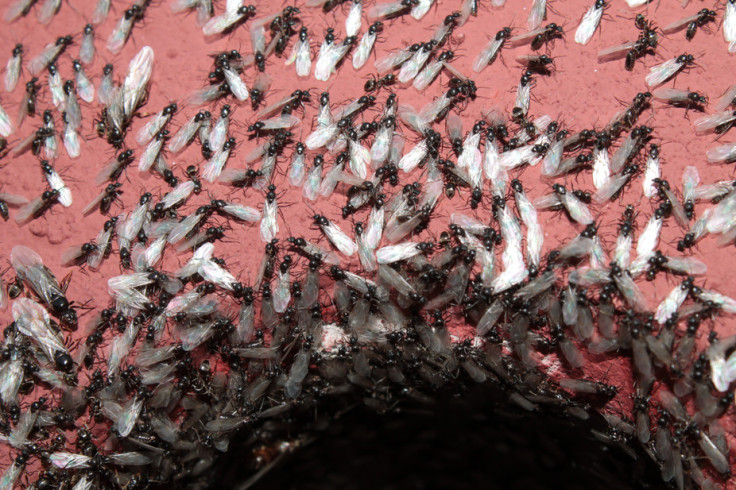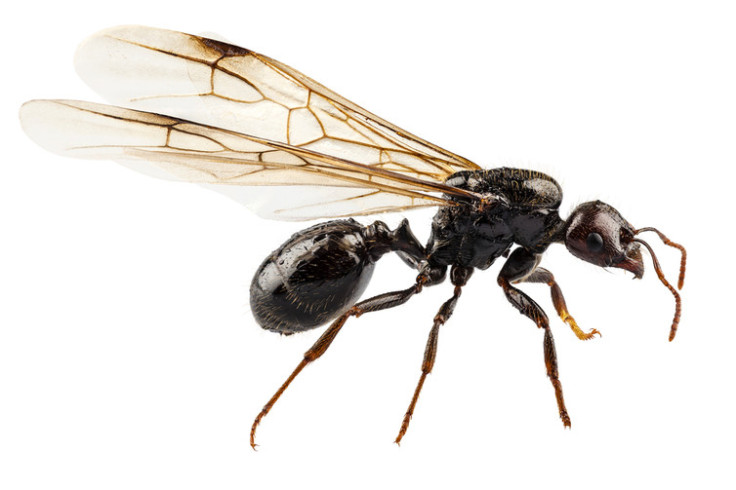Flying Ant Day: Insect apocalypse now
If flying ant day fills you with horror, be afraid. There will be many more before the summers over.

Here they come …
A steady stream of black ants scurries busily in and out of a crack in the patio. They've been living there quietly for weeks. Perhaps you tried to get rid of them – especially if they were taking sugar from the kitchen or crawling across your bedroom. Perhaps you ignored them, or marvelled at their ability to navigate over apparently featureless paving stones back to their nest.
Then we have a spell of warm weather, a summer downpour, and when it stops there are winged explorers erupting from the ground – welcome to flying ant day.
But what exactly is flying ant day? For a start, it isn't just one day. Recent surveys have shown that winged ants emerge over several weeks, although there are usually several large peaks. This is what happened in 2016, with many synchronised events in early August.
The Royal Society of Biology recently began working with entomologist Adam Hart from the University of Gloucester (who studies insects). He said:
"Many people tend to think that there is one national flying ant day, and the media are keen to report it, but our research has shown that's absolutely not the case. As in previous years we have seen many 'flying ant days' across the country this summer."
Since swarming is triggered by temperature and often occurs after summer rain, ants over a large area can appear on the same day if conditions are similar across it. Millions can be on the wing, and after a short or much longer flight, can land anywhere – on trees, cars and clothing. Plenty more get eaten.
Flights of fancy
Flying ant day is a mating event or nuptial flight, and in Britain a common participant is the small black ant, Lasius niger (Formicidae). Lasius niger builds its nests in soil, tree stumps or under paving stones, so patios are a favourite choice.
The colony starts with one or more mated queens. These tend the larvae until sufficient workers (less than half the size of the queen, and all sterile females) have developed. Usually only one queen survives and she will reproduce until the colony is 4,000-7,000 strong, which may take several years. Some large nests can have over 20,000 workers, which live for only a few months. Intriguingly, queens may survive for two decades or more and are thought to be the longest lived of all adult insects.

With plentiful food, each spring and summer the colony grows. Fertilised eggs normally develop into workers, but virgin queens are produced at high colony density, in a process determined by the queen. These new queens are winged, as are the males produced from unfertilised eggs. Males do not work, their only role is to fertilise a virgin queen, and this often occurs on the wing.
Unlike honey bees, where the new queen takes over the colony and the old queen leaves with a swarm of workers, in Lasius niger and other ants, the old queen remains. Instead, hundreds of reproductive males and females (drones and "princesses") emerge from the nest – hence flying ant day.
What are the advantages?
Basically: maximising genetic mixing, minimising losses to predators, and overcoming low probability of success. All ensure survival and dispersal of the species.
Genetic mixing is enhanced by virgin queens and drones first scattering. This is to maximise the chance of mating between different colonies to reduce inbreeding – something commented on by Charles Darwin in relation to plants. (Remember that all the colony ants were produced by one queen, so have high genetic similarity.)
After dispersing, the "princesses" release pheromones to attract drones, but often play hard to get – they fly to escape converging males, allowing only the fastest and fittest to mate.
Mass emergence does provide a rich food source, which can attract predators. However, massed prey benefit from safety in numbers, which reduces the likelihood of any one organism being eaten. If they present in small numbers they are more vulnerable, since this can train the predators, who will remain in the area. This is why other insects, such as cicadas, behave in the same way.
Even so, each potential queen has little chance of success. During its lifetime a large ant colony can disperse thousands of princesses, but on average only one will succeed. Which is probably just as well – otherwise, there would be very rapid growth in the number of ant colonies. Many succumb to predators: birds, dragonflies, often other ants, or die from starvation or environmental hazards. The first brood may fail, and the young colony can die out. Collectively, these mortality factors impose strong selection that ensures the queen has maximum fitness to produce the next generation. She also has to be lucky.
The secret of a long life
And what of the drones? Mating occurs in flight or on the ground, and since a queen usually mates with several males, this increases her offspring's genetic diversity. The queen keeps a lifetime's store of sperm in an abdominal structure called a spermatheca, from which hundreds of thousands of eggs are fertilised. The drones, meanwhile, die in a day or two.
At the end of the nuptial flight, the fertilised queens land, chew off their wings and starts a new colony, where – if successful – they will stay for the rest of their lives.
But how do queen ants live for so long? Lasius niger queens can live for over 25 years – and understanding why has interested researchers looking into the causes of ageing. There are well catalogued environmental reasons for longer life, including a protected environment and a secure food supply without the risks of hunting, but it was recently reported that queens have a higher expression of those genes necessary for repair of DNA damage and the breakdown of proteins than genetically identical workers.
It's fertile ground for further research from under a crack in the paving stones.
Christopher Terrell Nield is Principal lecturer of bioscience at Nottingham Trent University
This article was originally published on The Conversation. Read the original article.

© Copyright IBTimes 2024. All rights reserved.






